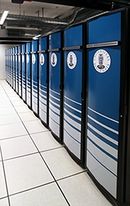Available resources: Difference between revisions
m 1 revision |
No edit summary |
||
| (21 intermediate revisions by 4 users not shown) | |||
| Line 1: | Line 1: | ||
== | == Historical Computational Resources at UIB == | ||
UiB | UiB historically had local supercomputer facilities that served the high-end computational needs of scientists at Norwegian universities and other national research and industrial organisations. Additionally, the systems were used for research and development by international organisations and were providing services to European research groups (and projects) as well as to cooperating scientists from international institutions. | ||
The installations | The installations were funded by the Norwegian Research Council through the NOTUR project, the University of Bergen (UiB), the Nansen Environmental and Remote Sensing Center (NERSC), the Institute for Marine Research (IMR), and Uni Research AS. These partners made critical use of the system for scientific research and development, in particular targeting marine activities ranging from marine molecular biology to the large scale simulation of ocean processes including the management of ocean resources and monitoring of the environment. Heavy use by academic research groups has traditionally come from computational chemistry, computational physics, computational biology, the geosciences, and applied mathematics. Sigma2 is an umbrella organisation which coordinates these efforts. Please refer to [https://www.sigma2.no Sigma2 website] for details. | ||
The | The last system UiB had was Cray XE6m-200, which was decommissioned on December 28th, 2018. | ||
=== | === Cray XE6m-200 (hexagon.hpc.uib.no) downscaled in 2017=== | ||
[[File: | [[File:hexagon_small.jpg|right|130px]] | ||
* | In 2017 XE6m-200 was reconfigured to 316 compute nodes. | ||
* | * 93.03 TFlops peak performance | ||
* | <!--* 63.33 TFlops measured HPL. - this was with 310 nodes, about 68 with 312 --> | ||
* | * 10112 cores | ||
* | * AMD Opteron 6276 (2.3GHz "Interlagos") | ||
** | * 632 CPUs (sockets) | ||
* | * 316 nodes | ||
* 32 cores per node | |||
* 32GB RAM per node (1GB/core) | |||
* | * Cray Gemini interconnect | ||
* | * 2.5D Torus topology | ||
* | * OS: Cray Linux Environment, CLE 5.2 (Based on Novell Linux SLES11sp3) | ||
=== Cray XE6m-200 (hexagon.hpc.uib.no) === | === Cray XE6m-200 (hexagon.hpc.uib.no) Full Configuration === | ||
[[File:hexagon_small.jpg|right|130px]] | [[File:hexagon_small.jpg|right|130px]] | ||
* 204.9 TFlops peak performance | * 204.9 TFlops peak performance | ||
| Line 35: | Line 33: | ||
* Cray Gemini interconnect | * Cray Gemini interconnect | ||
* 2.5D Torus topology | * 2.5D Torus topology | ||
* OS: Cray Linux Environment, CLE | * OS: Cray Linux Environment, CLE 5.2 (Based on Novell Linux SLES11sp3) | ||
It was upgraded from Cray XT4 in March 2012. | It was upgraded from Cray XT4 in March 2012. Cray XT4 was first time installed in 2008, it was in the top 50 world fastest supercomputers and was ranked on place 47 on the TOP500, June 2018 list. | ||
=== | === Older systems === | ||
[[ | A page that lists all HPC equipment that was once operated by Parallab can be found [[Resource History|here]]. | ||
UiB page on the Top500 list [https://www.top500.org/site/49135 University of Bergen TOP500] | |||
Latest revision as of 09:41, 4 August 2020
Historical Computational Resources at UIB
UiB historically had local supercomputer facilities that served the high-end computational needs of scientists at Norwegian universities and other national research and industrial organisations. Additionally, the systems were used for research and development by international organisations and were providing services to European research groups (and projects) as well as to cooperating scientists from international institutions.
The installations were funded by the Norwegian Research Council through the NOTUR project, the University of Bergen (UiB), the Nansen Environmental and Remote Sensing Center (NERSC), the Institute for Marine Research (IMR), and Uni Research AS. These partners made critical use of the system for scientific research and development, in particular targeting marine activities ranging from marine molecular biology to the large scale simulation of ocean processes including the management of ocean resources and monitoring of the environment. Heavy use by academic research groups has traditionally come from computational chemistry, computational physics, computational biology, the geosciences, and applied mathematics. Sigma2 is an umbrella organisation which coordinates these efforts. Please refer to Sigma2 website for details.
The last system UiB had was Cray XE6m-200, which was decommissioned on December 28th, 2018.
Cray XE6m-200 (hexagon.hpc.uib.no) downscaled in 2017

In 2017 XE6m-200 was reconfigured to 316 compute nodes.
- 93.03 TFlops peak performance
- 10112 cores
- AMD Opteron 6276 (2.3GHz "Interlagos")
- 632 CPUs (sockets)
- 316 nodes
- 32 cores per node
- 32GB RAM per node (1GB/core)
- Cray Gemini interconnect
- 2.5D Torus topology
- OS: Cray Linux Environment, CLE 5.2 (Based on Novell Linux SLES11sp3)
Cray XE6m-200 (hexagon.hpc.uib.no) Full Configuration

- 204.9 TFlops peak performance
- 22272 cores
- AMD Opteron 6276 (2.3GHz "Interlagos")
- 1392 CPUs (sockets)
- 696 nodes
- 32 cores per node
- 32GB RAM per node (1GB/core)
- Cray Gemini interconnect
- 2.5D Torus topology
- OS: Cray Linux Environment, CLE 5.2 (Based on Novell Linux SLES11sp3)
It was upgraded from Cray XT4 in March 2012. Cray XT4 was first time installed in 2008, it was in the top 50 world fastest supercomputers and was ranked on place 47 on the TOP500, June 2018 list.
Older systems
A page that lists all HPC equipment that was once operated by Parallab can be found here.
UiB page on the Top500 list University of Bergen TOP500